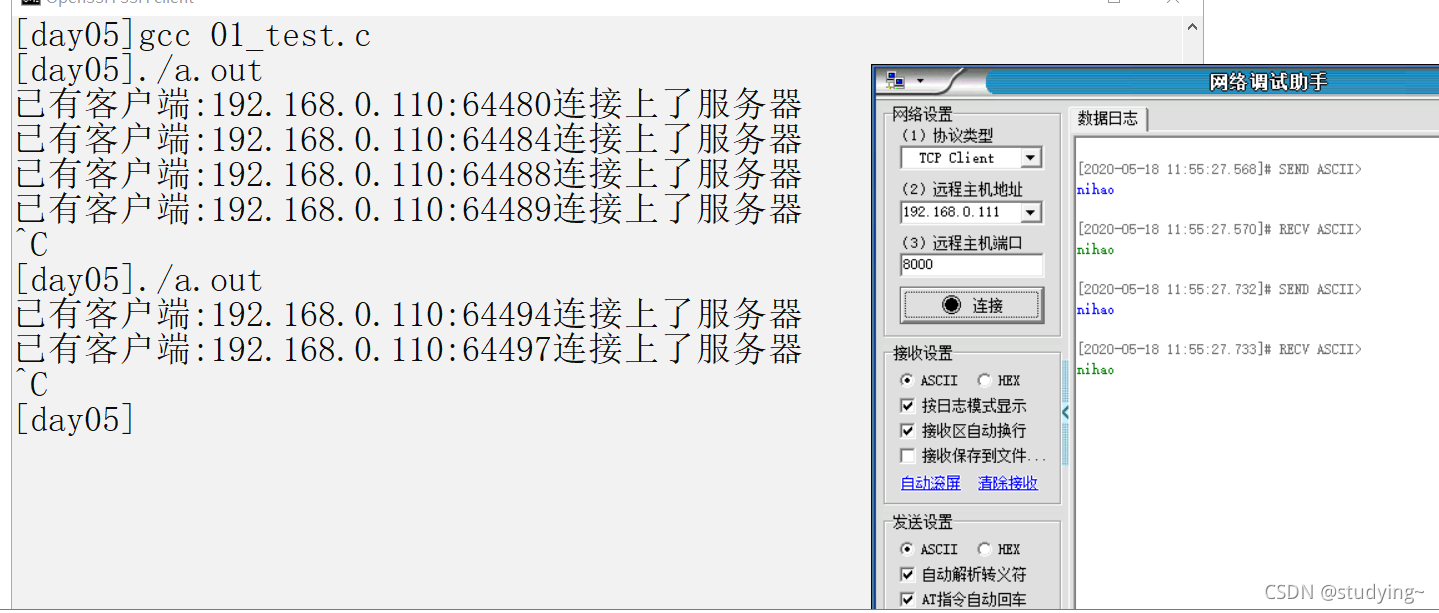TCP并发服务器的注意点:
TCP服务器、提取多个客户端、开启进程或线程处理每个客户端
1、多线程(常用)

#include<stdio.h>
#include<sys/types.h>
#include<sys/socket.h>
#include<netinet/in.h>
#include<arpa/inet.h>
#include<string.h>
#include<pthread.h>
//TCP并发ECHO服务器(并发回执服务器---客户端给服务器发啥 服务器就给客户端回啥)
void* deal_client_fun(void *arg)//arg = &new_fd
{
//并发服务器的核心服务代码(各不相同)
//通过arg获得已连接套接字
int fd = *(int *)arg;
while(1)//以下语句是服务器的核心代码
{
//获取客户端请求
char buf[128]="";
int len = recv(fd,buf,sizeof(buf), 0);
if(len == 0)
break;
//回应客户端
send(fd, buf, len, 0);
}
close(fd);
}
int main()
{
//1、创建tcp监听套接字
int sockfd = socket(AF_INET, SOCK_STREAM, 0);
if(sockfd < 0)
{
perror("socket");
}
int yes = 1;
setsockopt(sockfd, SOL_SOCKET, SO_REUSEADDR, &yes,sizeof(yes));
//2、给TCP监听套接字 bind固定的IP以及端口信息
struct sockaddr_in my_addr;
bzero(&my_addr,sizeof(my_addr));
my_addr.sin_family = AF_INET;
my_addr.sin_port = htons(8000);
my_addr.sin_addr.s_addr = htonl(INADDR_ANY);
int ret = bind(sockfd, (struct sockaddr *)&my_addr,sizeof(my_addr));
if(ret == -1)
{
perror("bind");
}
//3、调用listen 将sockfd主动变被动 同时创建链接队列
listen(sockfd, 10);
//4、提取完成链接的客户端 accept
//accept调用一次 只能提取一个客户端
while(1)
{
struct sockaddr_in cli_addr;
socklen_t cli_len = sizeof(cli_addr);
int new_fd = accept(sockfd,(struct sockaddr *)&cli_addr , &cli_len);
//遍历客户端的信息ip port
unsigned short port=ntohs(cli_addr.sin_port);
char ip[16]="";
inet_ntop(AF_INET,&cli_addr.sin_addr.s_addr, ip, 16);
printf("已有客户端:%s:%hu连接上了服务器\n", ip, port);
//对每一个客户端 开启一个线程 单独的服务器客户端
pthread_t tid;
pthread_create(&tid,NULL, deal_client_fun, (void *)&new_fd);
//线程分离
pthread_detach(tid);
}
//关闭监听套接字
close(sockfd);
return 0;
}
运行结果:

上述代码 如果客户端 正常退出 不会有啥影响,但是如果服务器 意外退出 绑定的端口信息来不及释放,就会造成 系统临时占用服务器上次bind的端口,如果在5~6分钟之内再次运行服务器 ,会导致新运行的服务器 bind失败

2、解决上述问题:端口复用 仅仅是端口的复用
服务器的进程网络资源 任然被占用 一般1分钟作用释放
int yes = 1;
setsockopt(sockfd, SOL_SOCKET, SO_REUSEADDR, &yes,sizeof(yes));
将上面的两句话添加到socket只有 bind函数之前
3、并发服务器 多进程实现

#include<stdio.h>
#include<sys/types.h>
#include<sys/socket.h>
#include<netinet/in.h>
#include<arpa/inet.h>
#include<string.h>
#include<pthread.h>
#include<unistd.h>
//TCP并发ECHO服务器(并发回执服务器---客户端给服务器发啥 服务器就给客户端回啥)
void deal_client_fun(int fd)//fd = new_fd
{
while(1)//以下语句是服务器的核心代码
{
//获取客户端请求
char buf[128]="";
int len = recv(fd,buf,sizeof(buf), 0);
if(len == 0)
break;
//回应客户端
send(fd, buf, len, 0);
}
return;
}
int main()
{
//1、创建tcp监听套接字
int sockfd = socket(AF_INET, SOCK_STREAM, 0);
if(sockfd < 0)
{
perror("socket");
}
//端口复用
int yes = 1;
setsockopt(sockfd, SOL_SOCKET, SO_REUSEADDR, &yes,sizeof(yes));
//2、给TCP监听套接字 bind固定的IP以及端口信息
struct sockaddr_in my_addr;
bzero(&my_addr,sizeof(my_addr));
my_addr.sin_family = AF_INET;
my_addr.sin_port = htons(8000);
my_addr.sin_addr.s_addr = htonl(INADDR_ANY);
int ret = bind(sockfd, (struct sockaddr *)&my_addr,sizeof(my_addr));
if(ret == -1)
{
perror("bind");
}
//3、调用listen 将sockfd主动变被动 同时创建链接队列
listen(sockfd, 10);
//4、提取完成链接的客户端 accept
//accept调用一次 只能提取一个客户端
while(1)
{
struct sockaddr_in cli_addr;
socklen_t cli_len = sizeof(cli_addr);
int new_fd = accept(sockfd,(struct sockaddr *)&cli_addr , &cli_len);
//遍历客户端的信息ip port
unsigned short port=ntohs(cli_addr.sin_port);
char ip[16]="";
inet_ntop(AF_INET,&cli_addr.sin_addr.s_addr, ip, 16);
printf("已有客户端:%s:%hu连接上了服务器\n", ip, port);
pid_t pid;
if(fork() == 0)//子进程 服务器客户端 不需要监听套接字
{
//关闭监听套接字
close(sockfd);
//服务于客户端
deal_client_fun(new_fd);
//关闭已连接套接字
close(new_fd);
_exit(-1);
}
else//父进程
{
//监听新的连接到来 不需要和客户端通信 必须关闭已连接套接字new_fd
close(new_fd);
}
}
//关闭监听套接字
close(sockfd);
return 0;
}
运行结果:

总结:
TCP并发服务器 进程版:父子进程 资源独立 某个进程结束 不会影响已有的进程 服务器更加稳定 代价多进程 会消耗很多资源。
TCP并发服务器 线程版:线程共享进程资源 资源开销小 但是一旦主进程结束 所有线程都会结束 服务器先对进程 不是那么稳定